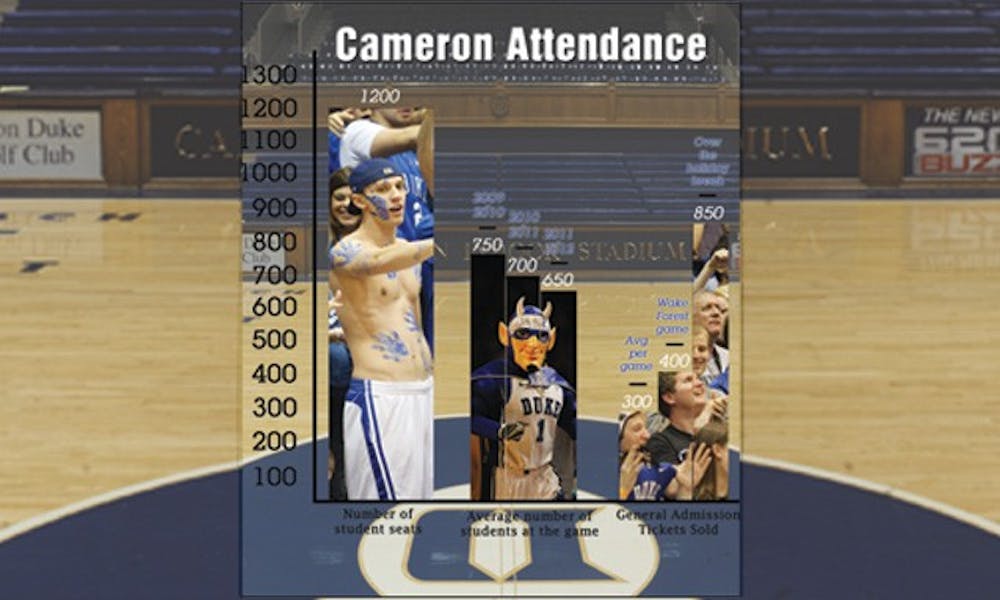Once regularly an asylum for 1,200 Crazies, Section 17 at Cameron Indoor Stadium now rarely plays host to a student-only crowd.
Student attendance at men’s basketball games has fallen consistently over the last five years, even dropping after Duke won its fourth national championship in 2010. This season, approximately 650 undergraduates have attended each game, 150 fewer than during the 2008-09 season. As a result, Duke Athletics has begun to sell an increasing number of general admission tickets in the student section on a regular basis.
“It has nothing to do with the revenue. We just want it to be full,” Director of Marketing and Relations Mike Forman said. “If there were 1,200 students every game we would love it.”
This is not the first season in which students have been accompanied by paying customers in Section 17, the 1,200-seat stretch of bleachers that run parallel to the court across from the team benches. Last season, Section 17 tickets were sold for every regular season home game except for Michigan State and North Carolina. Approximately 850 tickets are sold to home games during winter break, reserving 100 spots for local students to attend.
“It does take a lot to go to K-Ville and wait outside, sometimes in the cold and in the rain, and then go into Cameron where you have to stand and jump up and down,” co-head line monitor Ellie Garrett said. “Students need to realize that going to Cameron is... an awesome experience.”
This lack of undergraduate interest has led Duke Athletics to sell about 300 tickets per game this season, priced at $65. The general admission tickets are offered first to Iron Dukes and then to football and women’s basketball season ticket holders. If there were still to be tickets remaining after that opportunity, they would be opened up to the general public, though that situation has yet to arise.
The head line monitors meet with Forman 10 days before each home game to approximate the number of undergraduates who will attend based on a variety of factors, including game time, day of the week and other campus events.
When the Blue Devils played Wake Forest last week, 400 tickets were made available to Iron Dukes because of concerns over the game’s competition with fraternity and sorority rush, along with the Demon Deacons’ struggles. Still, Section 17 was still under capacity at tip-off, leading head coach Mike Krzyzewski to gesticulate across the court during play, encouraging the fans to get louder.
No general admission tickets have been sold for this Saturday’s game against St. John’s, however.
“The enthusiasm hasn’t been there,” Forman said. “[Head coach Mike Krzyzewski] has had to drum up enthusiasm himself, which he shouldn’t have to do. The students should be doing that themselves... whether 500 or 1,200 of them are there.”
One of the biggest causes of the declining attendance is the students’ misconception of the time commitment involved, Garrett said, along with the increasing prevalence and popularity of online streaming on sites like WatchESPN.com.
“The rumor we’ve had to deal with over the past couple years is that it’s hard to get into games, and if you show up half an hour before tipoff you won’t get in,” Garrett said. “We’ve been trying really hard... to really debunk those rumors because they’re simply not true.”
Another part of the problem has been an underwhelming home schedule over the past several years due to a down ACC and marquee nonconference matchups moving to Madison Square Garden. Duke has played just three ranked nonconference teams in Cameron Indoor Stadium over the last four years, and only three ACC teams are currently placed in the Associated Press Top 25.
Diminishing student attendance is a national trend, Forman said, and collegiate sports marketing departments have been combating it in a variety of ways. Many have altered their in-game experiences to become more engaging during stoppages in play, especially timeouts and halftime. Over the last few years, Duke has begun incorporating highlight videos, player introductions and popular music into its pregame festivities, but the marketing department currently has no plans to significantly alter the in-game atmosphere.
“Every other school in the country is playing canned music during timeouts, doing cheesy promotions,” Forman said. “We try to stay away from that.”
During the offseason, the sports marketing staff plans to investigate more of the underlying factors of the undergraduate attendance decline. Until then, though, the few students left will just have to get Crazier.
Get The Chronicle straight to your inbox
Signup for our weekly newsletter. Cancel at any time.

